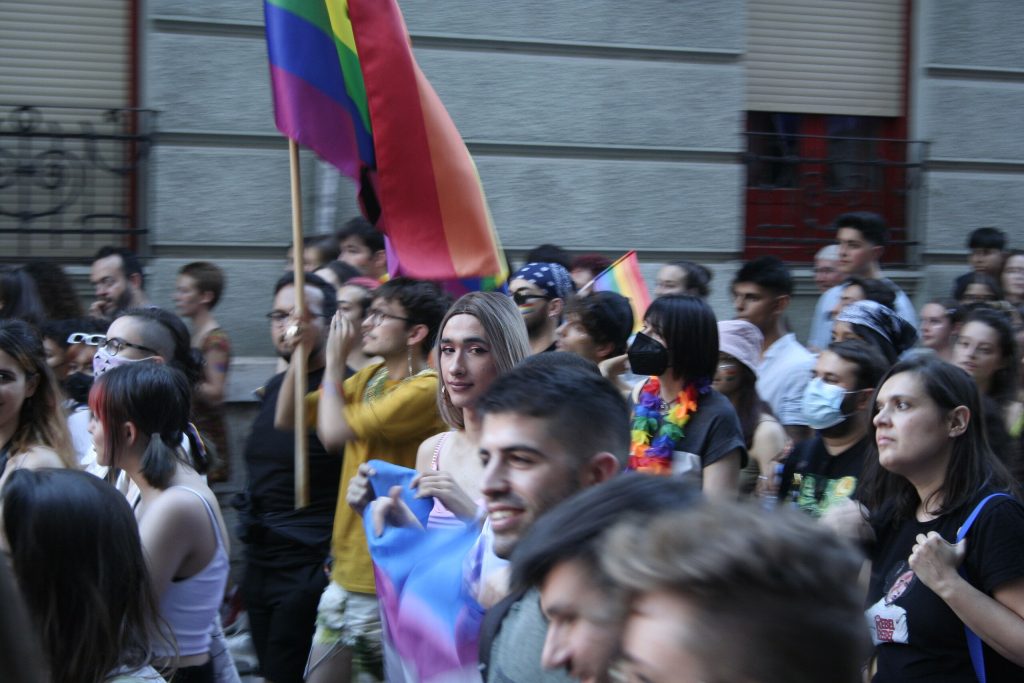‘The modern world has established the border between our madness and their sanity … Enlightened despots of the 21st century always have something to say,
even if we haven’t asked them to.’
P.B. Preciado.
It is a hot first day of June and Roma and I are sitting on a terrace in Barcelona’s old Masadas Square. She is wearing a white t-shirt, a short black denim skirt, fishnet stockings and platform boots. Her hair is long on the top, shaved on the sides, dyed black and white. She is tall and her back is straight. Even though we have been sitting for a while, she does not relax her spine to arch it comfortably on the backrest of her chair. We order coffee and, with her permission, I start recording.
Roma identifies two main ruptures in her transvestism: when she moved out of her mother’s home at the age of 16, and when she migrated from Argentina to Barcelona at the age of 27. The first was a liberating scream: ‘Mom, I am a faggot! Neighbour, I am a faggot! You, whoever you are, know what? I am a faggot!’ The second was a comfortable sigh. She became the daughter of a transvestite mother, who remains in that role to this day. ‘Transvestism is my home, my nest, my shelter,’ confides Roma.
She says had a ‘range of privileges’: university studies, student activism and an academic career. But she is no longer interested in them. She rejects the institution per se. Not from a ‘typical European anarchist view, as in death to institutions’ – quite the opposite. She believes that ‘there are changes that if they do not occur in the institutions, they won’t occur at all’. However, she enjoys the view from the outside much more, because: ‘Why aren’t transvestites in universities doing master’s degrees?’
On 10 March 2022, at the launch of her book Catalan Scenes: Anthropological-Sexual Errors, the transvestite artist Frau Diamanda was introduced in the following manner: ‘It is a privilege to be listening to Frau Diamanda here with us because she is a literate transvestite’. ‘Excuse me, love’ – Roma replied – ‘the privilege we have here is to listen not to a literate transvestite, but to a Peruvian migrant transvestite telling us how she sucks the cocks of rich heterosexual males in Barcelona’. Notably, the book launch did not take place in some dark corner bodega, but in MACBA, one of the most renowned museums in the city.
Here is a paradox that troubles Roma: ‘Ninety per cent of the trans community that migrated to Europe will never go to university. You will find them on the streets. And I don’t say that as a deficiency at all. It is part of their life experiences: This institution [the university] means nothing to this [my] body.’ She said this as she formed a circle with her arms, making clear who ‘this body’ was: the entire body of trans people who migrated and never went to university; the collective, the image, the symbol, the story and the flesh.
Although transness can be categorized under the umbrella of ‘gender’, its conceptualization on both an intimate and structural level requires an intersectional approach. Roma’s vignette illustrates the simultaneous interplay of gender identity, gender expression, class struggle, construction of the ‘self’, migration and class (im)mobility. The following historiography tries to show how transness transcends gender. To understand it more profoundly, one must bear in mind many other factors and layers, ‘class’ being one of the most important.
From transvestite to transfeminist
The history of trans identities in Spain can be traced through four historical stages: (1) the transvestite period (mid-1970s to the early 1990s), a time marked by violence and discrimination against trans people, as well as a time of self-management of the body due to the lack of recognition by official institutions; (2) the transsexual period (mid-1990s to the 2000s), when some institutions recognized and financed healthcare for trans people, but through a pathologizing prism; (3) the transgender or trans period (2000s until now), ‘characterized by the struggle for de-pathologization, and conceptualization of transgenderism as a socio-cultural issue that goes beyond healthcare’; and (4) the transfeminist period (2010s until now), when some critical branches of the trans movement rejected the binary model still governing trans identities, and sought corporeal and identity autonomy beyond it.
The Spanish political arena in the 1970s was filled with countless tensions between the supporters of the fascist regime and those who favoured democracy. After Francisco Franco’s death in 1975, the political transition led to a system of new freedoms safeguarded by the 1978 Constitution. However, despite such successes, the shadows cast over sexual and gender minorities should not be overlooked.
During the 1970s and 1980s, the courts criminalized cross-dressing, treating it as public scandal. Cross-dressing men, called transvestites or travestis, were considered homosexuals who were not man enough and therefore had to be hidden away. Their employment opportunities could be in show business, at best, but more frequently in sex work. In Roma’s words: ‘Spain has a very long history of its transvestites, but it is a history of erasure, of sanitization.’
In the late 1970s and early ’80s, the Penal Code considered sex reassignment surgery an illegal form of castration – those who wanted to transition physically could only do so through self-management practices (hormone intake, binders, corsets or silicone injections). ‘The more experienced transgender people would advise the less experienced ones about medicines and dosage,’ one trans person remembers. There was no shortage of health problems deriving from these practices, mostly due to hormone overdose or low-quality drugs. ‘We all injected hormones. I don’t know how many times a week we took pills … It was like a fight against the clock.’
The transition to democracy brought about a more tolerant atmosphere that allowed the LGBTIQA+ community to more vocally claim their rights; this led to the de-pathologization of homosexuality in 1973 and its de-criminalization in 1979. However, trans people continued to be discriminated against after 1983, if not more so, when transsexuality (‘gender dysphoria’) was included in the DSM-IV as a mental disorder, together with sadism, voyeurism, frotteurism, exhibitionism, fetishism and masochism.
By the end of the 1980s, the first trans associations were formed: Transexualia in Madrid (1987) and Col·lectiu de Transsexuals de Catalunya in Barcelona (1992). These organizations’ main concern was the safety of transgender people: they were being violently evicted, even killed in broad daylight, and institutional and social transphobia was only increasing after the spread of the HIV epidemic and the stigma that came with it. In Barcelona, two key events in 1992 triggered the collective’s founding. First, the murder of a trans woman, Sonia, in Ciutadella Park by a group of skinheads, who beat her to death in broad daylight. Second, the construction of the Olympic Stadium in a neighbourhood with a strong presence of trans sex workers. The government decided that they had to be removed, and the police were tasked with violently evicting them.
Solidarity across struggles
The nascent gay community inspired by the Front Homosexuel d’Action Révolutionnaire (FHAR) also excluded trans people from their movement, since they wanted to present a ‘serious’ image of homosexuality. Non-conforming gender expression, such as the extravagant femininity of the travestis, was seen as the stigmatizing and ridiculous fruit of the fascist period, which had to be rejected. They maintained that sexual liberation had to go hand in hand with the fight against capitalism and the bourgeoisie, and they criticized non-political gay spaces as alienating, hedonistic and eroticosexual places that deviated from and sabotaged the real fight. As the famous trans performer Pierrot put it in her memoirs: ‘When the Sixties ended their mediocre existence, I cruised around Barcelona convinced that a poor fag was a fag, and a rich fag was just a rich person’.
Most existing testimonies, with a few exceptions, suggest that the Spanish homosexual and trans world of the 1970s was dominated by people of low economic status. Furthermore, in Barcelona, law enforcement and the courts implemented so-called ‘class justice’ (justicia de clase), in which middle and upper-class homosexuals with a stable profession would not face punitive measures prescribed by laws against homosexuality.
Class struggle is a very prominent theme in all trans biographies. ‘No one will be surprised to find that during Franco’s long night there was not only a double standard in sexual matters, but also an equally hypocritical class factor in the expression and repression of (homo/trans)sexuality.’ Pierrot was not protected by her background and spent three months in jail because she walked to her friend’s place in ‘women’s clothes’ to wish her a merry Christmas. The reason? Public scandal. Justice? You may get justice in the next world, in this world you just have the law.
At this double crossroads, firstly between sexuality and gender diverse communities against the ‘norm’, and secondly between different approaches within sexuality and gender diverse communities, the Spanish lesbian community opted to distance itself from the gay movement, and gravitated towards feminism, thus getting closer to the emerging transsexual collectives. Lesbians considered themselves women first; their gender identity came before their sexual orientation.
According to Mas, this is a Spanish particularity that differs from other contexts where lesbians were closer to gay movements than to feminist ones. The lesbian community in Spain also did not want to be associated with the ‘butch’ aesthetic, which they believed emulated the same old heterosexual paradigm that they wanted to eliminate. You do not need to look like a man to love a woman – if you look and act like a man who loves a woman, you perform heterosexuality. Spanish lesbians claimed their lesbianism as women-looking women who love other women-looking women.
‘For us, lesbian feminists in the Seventies and Eighties, the contact with trans women was a flash, love at first sight’, says Cristina Garaizábal, one of the icons of lesbian feminism in Spain in the 1970s and ’80s, and the first psychologist to support transition processes. Nowadays, she is also one of the main voices for transfeminism. I had been told by several people that if I wanted to understand the trajectory of transfeminism in Spain, then Cristina was the person I needed to talk to.
When I found myself finally sitting in front of her, I understood why. Professionally, she defines herself as a clinical psychologist with a psychoanalytic orientation. Originally from Barcelona, she moved to Madrid in the 1980s during the freeing and effervescent time popularly known as La Movida. It was while preparing a protest platform with her activist group of lesbian feminists that they first wondered: ‘Shouldn’t we include trans women too?’ They visited the Transsexualia organization and ‘it was an absolute infatuation’. Having built their feminism and womanhood on the basis of their biological sex, they now suddenly met women who did not develop it from there. ‘What’s going on? What’s up with our ideas? I started to get the bug of the trans thing inside of me.’
Cristina told me that in Spain, everything related to transsexuality at that time was penalized. There were no doctors or psychologists who dared to do anything; the pressure and stigma were too heavy. But when Cristina was asked to give psychological support to trans people in the organization, she agreed. Her partner Empar Pineda (also a lesbian feminist icon in Spain) ‘was at that time helping women to get illegal abortions,’ so she managed to get contacts of doctors from the Harry Benjamin Association in Amsterdam, ‘who were amazing’. They managed to create a solid support network, with psychologists and endocrinologist Antonio Becerra, ‘who is still today the best in the field’. Cristina was likely the first person in Spain to accompany trans people in their transitions, work that she still does today.
However, this work has changed radically over the decades. The 1990s were part of the transsexual period, when the public health sector started providing treatments, but only through the utter pathologization of the person’s experience. As Cristina says:
Because of it being pathologized, trans people mostly wanted a diagnosis … But how could I diagnose that a person is trans? Through what instruments? I could only observe and listen to how they felt. I came from feminism, so I believed that one is not born, but becomes a woman, as Simone de Beauvoir said; if we assume that we are women through a social and educational process, it means that they can do it just like we did, don’t they? It is not a pathology. It is a development of gender identity different from the norm.
Cristina was one of the first people to openly say that transsexuality was not a disease, and therefore, no psychological report was needed. But at the same time, such a report was necessary to access healthcare. So she decided to write in the reports: ‘Mental pathology is ruled out but the person is indeed trans’. Cristina laughs when she recalls this.
In 2005, same-sex marriage and adoption were allowed by the Spanish civil code, and LGBTIQA+ rights started to be seen as, simply, human rights. Nevertheless, for trans people, change was much slower. In 2007, a new law was passed, which allowed for name and sex changes on official documents. But in order to be eligible for it, trans people had to undergo a long and difficult medicalization process. First, they had to be diagnosed with gender dysphoria by a psychiatrist, who would then validate their gender; then, they had to pass a real-life test, in which they had to adopt the social appearance of their experienced gender, changing their outfits, hairdos, etc.; other experts then had to observe this new role and confirm the diagnosis; only then was hormonal treatment started. Finally, after months or years in a waiting list, they got an appointment for surgery.
Paul B. Preciado describes this process very vividly:
Given the current state of things, it seems more prudent to me to label myself a transsexual and let the medical establishment believe that it can offer a satisfying cure for my ‘gender identity disorder’. In that case, I’ll have to accept having been born in a biobody with which I don’t identify (as if the body could be a material given that is there before linguistic or political action) and claim that I detest my body, my reproductive organs, and my way of getting an orgasm. I’ll have to rewrite my history, modify all the elements in it that belong under the narrative of being female. I’ll have to employ a series of extremely calculated falsehoods: I’ve always hated Barbie dolls, I’m repulsed by my breasts and my vagina, vaginal penetration makes me sick, and the only way I can have an orgasm is with a dildo. All this could be partly true and partly nonsense. In other words, I’ll have to declare myself mentally ill and conform.
Despite being the main target of the 2007 law, the transgender movement had been largely excluded from negotiations over its development. The law medicalized and pathologized trans people, reinforcing the ‘social control over gender diversity in ways that threatened the identity and bodily autonomy of transgender people.’ As Monica, one of Mas’ sources and a transgender woman. says:
They were afraid of the reversibility of gender, but this is nonsense. Gender is reversible, admit it. If transsexuality shows something, is that gender is reversible … For me, the ideal law would have been a simple bureaucratic procedure, like a change of address. When you get married, do you take a psychological test? Why is there so much paranoia about gender?
The pathologizing gaze
Medical institutions tried to give room to new ontological categories of being: that trans people had a disorder because they were born in the ‘wrong body’. But many people did not feel right about being assigned such a pathologising category. The transition from self-managed hidden travesti to medicalized and monitored transsexual forced trans people to view themselves as biological anomalies, abnormalities of nature, which soon provoked rejection within the trans movement. Being able to legally benefit from access to public healthcare treatments was a relief, but the psychological cost was still very high.
As of 2008, medical treatments for transgender people were incorporated into the catalogues of benefits of the public health system, and in 2009 the first law committed to the non-pathologization of transgenderism was approved in Catalonia – though it was never applied. Each region also designated which medical unit would oversee which treatment, and established how many interventions could be carried out each year. The waiting lists only got longer. Griselda, a transgender coach, teacher and actress in the aesthetic method of the Theatre of the Oppressed started her transition ten years ago: ‘In the beginning, you had to go to Hospital Clínic and wait on an eternal waiting list just so that you could start dealing with this issue. Not only to get hormones but just to be heard by someone. We must remember that today it is still considered a mental illness here in Spain.’
Many trans people ended up turning to private clinics if they did not want to wait for years just to get an appointment. Even now it is still exceptional to meet someone who has had transition surgery in the public system.
Miquel Missé argues that there is nothing inherently biological about transgenderism, just as there is nothing biological about cisgenderism. A binary way of being has been imposed on our bodies, and that is only – and merely – a hegemonic cultural construction. Missé argues that if society were more open to a plural and diverse range of gender expressions, there might not be a need for transition at all. There would be no destination, because there would be no departure in the first place. We would all live somewhere on a spectrum, as so many before have suggested.
The point here is not to ignore ‘biology’ altogether, but to not let it overshadow the cultural. However, a doctor cannot send you home because the problem is not in you but in society. Or can they? As Miquel Missé writes at the start of his book, On the Conquest of the Wrong Body:
I feel the strange sensation that my body has been stolen. In fact, I feel like it’s been taken away from trans people in general … I mean that we have been robbed of the possibility of experiencing the body in another way, that a unique interpretation of some of its parts has been imposed on us … When I started my transition, I was not told about other possibilities beyond medical treatment … Right now, it would seem that the biggest demand of trans movements in different parts of the world is the right to access hormonal and surgical treatments to change the body. But my feeling is that posing the right to trans body modification as the solution to our malaise can be downright problematic. What is the origin of the discomfort we feel? What if the origin of our discomfort was not in our body? Would the remedy still be in the body?
The pioneering health service for trans people Trànsit was established in Barcelona in 2012. Its model operated on the premise of ‘informed consent’, through which transgender people, without a psychiatric diagnosis and only opting for psychological support if desired, would solely determine their transition process after receiving the necessary counselling and information. Unlike previous ‘gender disorders’ hospital units’, where medical professionals usurped their patients’ agency to decide over their own bodies, Trànsit offered only accompaniment. Thus, the trans person leads the decision-making regarding their own transition, a process which is more respectful and truthful with the diversity and autonomy of trans people. Trànsit is one of the first clinics in the world to practise this approach.
The Catalan government’s Health Department approved the model proposed by Trànsit in 2016, but there are still many fields that have not adapted to the new reality of gender diversity. ‘Ultimately’, writes Mas Grau, medical intervention needs to be just one action among others in different spheres such as the labour market, education, public space and community relationships.’
Beyond the binary
Transfeminist scholars and activists have thoroughly analysed existing research on gender in order to challenge notions that are otherwise taken for granted. For instance, ‘the pursuit of corporal and identity autonomy freed from the gender binary.’ The felt gender that does not fit in the binary system is not the one that needs to be fixed to fit in; rather, the system itself must be fixed to fit more people without sanctions and over-managements. ‘Feeling discomfort with gender is not a minority experience, reserved for trans people only’ – trans identities visibilize a discomfort with gender rigidity, just as plastic surgery does.
Am I feminine enough? Am I masculine enough? Trans people are part of a larger group of both trans and cis people who embody a protest against the gender binary and turn their bodies into a place of dispute, of reclamation. The protest may be to tame the rigidity, to succumb to it, to reify it, to compensate for it in other ways, and transitioning is just another form of dispute and reclamation.
The freedom to explore one’s own gender is tied to the notion of ‘identity’, which is the double-edged sword that transfeminism must navigate. Similar to how rigid canons of femininity and masculinity have emerged, trans identities have also been shaped by arguments over the limits of transness, ‘who can call themselves trans and who cannot, who undergoes surgery and who does not, who is an authentic trans person and who is not’. These new ‘trans normativities’ coexisted with the shared fight against depathologization, which affected all trans people – whether ‘normatively trans’ or not.
However, after its depathologization through the 2023 Law for the Equality of Trans People and Guarantee of LGBT+ Rights, ‘transsexuality’ could no longer be diagnosed – there was thus no official way of stipulating who is trans and who is not. Trans movements had won the battle over not getting that legitimacy from the outside, but this now meant they had to figure out those answers themselves. At this point, some of the most essentialist transsexuality discourses re-emerged. But it was precisely the alliance with the feminist movement and the consolidation of ‘transfeminism’ which provided one of the ‘greatest advancements of the trans movement: the antidote against identity essentialism’. In other words, gender identity is not something fixed, closed, unequivocal or final.
There are trans people who want to modify their bodies and others who do not. There are trans people who prefer self-management and others who prefer to use the available institutional support. There are trans people who still feel there is something wrong in their bodies, no matter how wrong they believe the ‘wrong body’ narrative is. There are trans people who want to do a binary transition and go all the way from one end of the spectrum to another. Others will take just one single step towards an in-betweenness, and find a safe space there. All my sources have shown different, sometimes ambivalent, interplays of narratives and experiences on their own gender journeys. But in the end, beyond their individual corpo-realities, the shared struggle is ‘for a new future in which the acceptance of gender diversity, as well as the identification of multiple dimensions of transphobia, are recognized as the real issues to be socially addressed.’
The ‘ley trans’: a step forward?
‘Everyone now wants to write about the Latin-American transvestites, but where are the Latin-American transvestites? Whoring in the street! And I am not criticizing your work!’ – said Roma, before she sipped her beer and touched her chest with her hand. I looked at her silently, almost cautiously, and then she added: ‘We must generate tools so that this body [the one that represents sexual and gender diversity], if it wants to reach that space [knowledge, state, policy-making, healthcare, etc], can access it.’
Eight months after my conversation with Roma, the front pages of the Spanish press featured the passing of the Law for the Equality of Trans People and LGBTIQA+ Rights (or ‘the Trans Law’), which develops and guarantees the rights of lesbian, gay, bisexual, trans and intersex people and seeks to eradicate discrimination to ensure everyone’s ability to live their sexuality, gender identity, gender expression, sexual characteristics and family diversity with full freedom.
The European Parliament had on several occasions voiced the need to protect the rights of trans people. And in the 2011 Human Rights, Sexual Orientation and Gender Identity Resolution, the United Nations pushed for the de-pathologization of trans identities, in 2020 presenting the first Strategy for Gender Equality in relation to LGBTIQA+ people, with the aim to combat discrimination, guarantee safety, build inclusive societies and promote equality around the world.
However, despite such initiatives to promote respect for gender and sexual diversity, recent studies show that structural and systemic discrimination against trans people persists in all areas, such as in access to public space, education, work or healthcare. In 2020, the European Union Agency for Fundamental Rights published the results of one of the largest studies carried out to date on discrimination and hate crimes against LGBTIQA+ people, which showed that one in five trans people surveyed has been physically or sexually attacked in the last 5 years.
During my fieldwork, all of the trans and nonbinary participants spoke about suffering harassment and violence in their daily lives, either on the streets, in their workplaces, or in the health system, among others, which shows that there is still an important gap between advancing theory and the bleak situation on the ground.
Kilian has experienced a lot of violence ‘for being effeminate’ (Kilian). Even though she does not consider herself solely a feminine person, her mannerisms, in contrast with her rather masculine appearance, ‘have been an object of ridicule in school’. She felt socially pressured to believe she was gay, even though she had mostly been attracted to girls. But, as she explained, ‘when you are a feminine man, you immediately are made to think that you are gay. When I realized I’m trans, everything made more sense, but there had been so much violence on my body already.’
Even though coming out as trans was a relief, Kilian keeps encountering structural discrimination in important spheres of her life. For instance, she explained how difficult it is to get a job when one wants to modify one’s body and physically transition. She has been wanting to start hormones for a year, but her two passions, ballet and restorative art, are both extremely rigid when it comes to gender expression. Ballet has very cis-heteronormative characters, in which the male dancer and the female dancer have specific roles and choreography. She could never get a role if her body is visibly trans. Regarding restorative art, all the job opportunities she has found so far require ‘good presence’, which is another way of saying ‘formal appearance’ in the Spanish cultural vox populi. ‘Who’s gonna care about my appearance if I’m gonna be working with dead people?’ – she wonders. Kilian cannot afford to pay rent or even the new computer she needs, which is why she keeps prioritizing her work and postponing her physical transition. Yet, that also constrains her to a difficult and restrictive life in other matters.
These kinds of choices are simultaneously very complex yet very common among trans people, who must navigate the contradictions between their trans identities and a heteronormative binary society that often makes their gender expressions incompatible with finding jobs, accommodations, or just walking the streets without harassment.
Nef feels they do activism every time they leave the house, just by existing outside the norm, wearing a certain outfit tor talking the way they talk. On their way to our interview, a man had laughed at Nef and called them ‘faggot’, to which Nef replied ‘Yes, I am’ – even though they are not, and blew a kiss at him. ‘You get so much violence that you learn to be defensive… You can’t imagine the looks I get from people in the street…’, they said, while timidly drinking Coca-Cola. ‘The hedgehog looks dangerous but it’s actually not dangerous at all… well, I had to change my aesthetics as self-defence, to put up a barrier, to make myself inaccessible.’
Just a few days earlier, a woman stared at them on the metro for 20 minutes. At first, they did not want to do anything about it, but then they thought: ‘If I don’t say anything, this person will do it again to someone else.’ In the end, they said, sarcastically: ‘do you want a photo?’. The woman started to complain that Nef was being disrespectful towards her, and then Nef told her: ‘No ma’am, what is disrespectful is to stare at me for 20 minutes straight; you must understand how uncomfortable that can make one feel.’ Nef told me about several of these situations, and finally said: ‘You know? Even though I’ve learnt to sometimes take it with humour, the truth is that in situations of violence, I always feel bad. Even when I manage to laugh, it still hurts.’
Griselda’s doctor did not recognize her gender dysphoria because she had been diagnosed with a schizoaffective disorder at the age of 16. The medical community stated that the dysphoria was caused by the disorder and that she was therefore not eligible to access any kind of gender-affirming care. When she discovered Trànsit, everything changed:
People with mental health issues used to be left out, but in Trànsit you weren’t asked any of these things, and suddenly Trànsit was a relief for all those people who didn’t meet the criteria. You don’t have to take a real-life test or anything like that. For me it was a light, it was like paradise … And, well, my life improved 100%. I started to be able to develop socially, start a transition … In fact, ever since I started the transition, I have not been hospitalized … What’s more, I think that part of my initial illness was due to the transphobia I experienced in childhood…
Àlex was fired from his job without any explanation. He does not even want to know why. His co-workers were older and showed no will to understand his transition. ‘They were such boomers. I didn’t feel comfortable saying it, I didn’t feel there was the space to express it.’ Àlex told his younger colleagues but nothing changed; they kept on calling him by his old name and treating him as if he were a girl. Àlex called his old name his ‘deadname’, which illustrates how important it is for him to be called ‘Àlex’ and how uncomfortable he feels when someone deadnames him.
The workplace is one of the main spheres of socialization in the daily lives of many people. It is a space where gender non-conforming people fight for the recognition of their gender identification and the freedom of their gender expression. Historic negative connotations that linked trans people with illness or criminality still influence how they are perceived nowadays, and for that reason, it is not uncommon to encounter trans people who hide their gender identity in order to access a work position, like in Kilian’s case, or who decide to be open about it at work but receive a very negative response, like in Àlex’s case.
These experiences show that in the current cis-heteronormative and binary system, gender cannot be disentangled from other intersecting forms of oppression. Not being able to work, or working precarious jobs, has been a constant account in Spanish trans narratives since the 1970s and it remains the case today. As much as this law represents an essential upgrade, the traditional conceptualization of transness as a mental disorder is still the legal imperative and a very widespread and powerful rhetoric that has not been overcome on a societal level. This rhetoric keeps trans people in the imaginary of ‘patients’, ‘victims’ or ‘disruptors’, all terms that sow a fertile ground for segregation and exclusion.
The Trans Law is a giant step in the Spanish social landscape and will ideally be a beacon for other countries. But this law is just one single step in a long journey towards a place where discrimination on the grounds of gender identity, gender expression or sexuality is a thing of the past.







